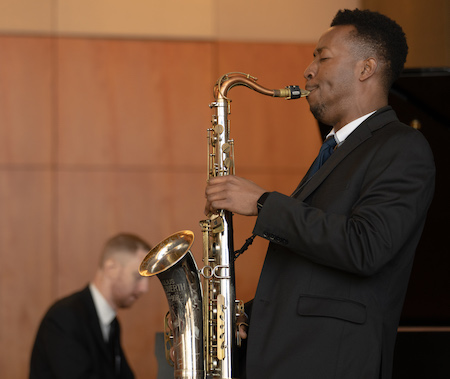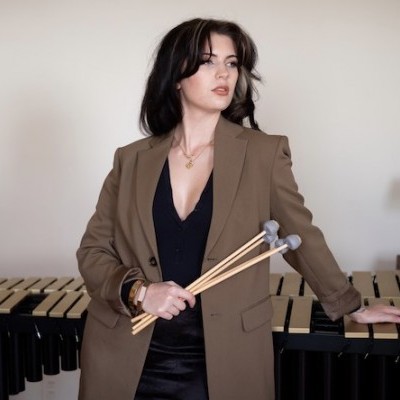Jun 3, 2025 11:25 AM
In Memoriam: Al Foster, 1943–2025
Al Foster, a drummer regarded for his fluency across the bebop, post-bop and funk/fusion lineages of jazz, died May 28…

Calvin Johnson appealed to listeners suffering from dementia during his Lincoln Center Moments program in December.
(Photo: Courtesy Lincoln Center)On a chilly Dec. 9 in New York, the charismatic reed player Calvin Johnson gazed out upon the 70 or so people assembled in Lincoln Center’s Stanley H. Kaplan Penthouse and prepared to deliver a dose of spiritual uplift.
Johnson, a fourth-generation New Orleans musician, had seen audiences like this before: people who risked being marginalized, in this case because of their dementia. And he had managed to reach them through Big Easy culture, about as universal a medium as one could find. The hope was that history would repeat itself.
“The dance floor is officially open!” he declared as he and his quintet, Native Son, launched into a thoroughly toe-tapping version of Fats Domino’s “I’m Walkin’” — the first offering in a set largely drawn from Johnson’s hometown canon.
As the music unfolded, much of the audience was roused to cheering, singing and all manner of excited gesticulation. If their gestures sometimes seemed out of sync with concertgoing ritual, that was OK. Rather than be put off by the mismatch, Johnson played to it. The result: disarming flashes of raw authenticity amid a performance of emotional depth.
“It went wonderfully, it was amazing, it exceeded my expectations,” an elated Johnson said in a phone call after the performance.
The performance was part of Lincoln Center Moments, a program that presents world-class entertainment for free to people with dementia and certain other conditions. It is part of a larger effort by Lincoln Center to improve access to and diversity in its programming.
In the program’s eight years, it has often recruited performers from Lincoln Center’s constituent organizations, including the New York Philharmonic and the Juilliard School. It has also reached outside these groups; veteran jazz trombonist Art Baron, for example, has had marked success engaging with the audience, according to Miranda Hoffner, associate director of accessibility.
Not all the artists recruited for the program have engaged so easily. Some have needed a fair amount of coaching. That was decidedly not the case with Johnson.
“Sometimes we try to gear our artists to highs and lows, a dynamic performance,” Hoffner said. “That is often helpful for this audience — to keep things changing and moving. But for him, that was not necessary because he already created that so beautifully in a set.”
Hoffner said that the program’s organizers enjoyed a preview of Johnson and his New Orleans repertoire at a family concert that Native Son — trombonist Stephen Walker, pianist Andrew McGowan, bassist Nori Naraoka and drummer Errold Lanier along with Johnson on vocals and tenor and soprano saxophones — gave in October at Lincoln Center’s David Rubenstein Auditorium. “He had a personal connection to the audience,” she said.
Expanding on that sentiment, a thoughtful man named Ira, who attends many Lincoln Center Moments performances with his wife, who has dementia, described Johnson’s December set as a series highlight: “He brought something more than music. He brought a style. He wasn’t intimidated by the audience. Sometimes I have a feeling that some of the performers are not totally comfortable with this audience. But he was right with us.”
Beyond his personal spark and musical gifts, Johnson’s sensitivity in executing the December performance owed in part to experience gained when, as a member of the Preservation Hall Jazz Band and under the auspices of its charitable foundation, he conducted workshops for people with Alzheimer’s, Down Syndrome and autism.
“When they approached me about this and told me of some of the parameters of what they were trying to accomplish,” he said, referring to the organizers of Lincoln Center Moments, “old habits somewhat kicked in and I knew exactly how I wanted to approach it.”
His approach, he said, began with making a connection through rhythm: “We had no reason to come in here and play an odd-meter song. You ever try to dance in 5 or 7? Certain things I just knew wouldn’t make sense. I was trying to pull people in.”
Keeping the improvisations concise also helped: “Don’t necessarily treat it like a club where you might stretch and try to develop a solo to tell a story. This is more like, ‘Give it to me in a paragraph. If I can’t comprehend it in a paragraph, it’s too long.’”
He also considered the vintage of most people with dementia: “I was thinking, ‘What songs will resonate with this generational demographic?’ And it hit me like a Mack truck: Fats Domino. Their guards were immediately down. They were open to receiving what we were presenting to them.”
Despite the straightforward presentation, the set did allow for some elasticity. “I’m Walkin’” ran nearly 10 minutes, as did the follow-up, Paul Barbarin’s “The Second Line.” While that tune and the closer, “When The Saints Go Marching In,” retained the texture of early jazz, Johnson’s arrangements offered modern harmonic colors and rhythmic tropes. In no way did he compromise artistically, nor was he asked to.
After the performance, Johnson participated in workshops, including one co-led by teaching artist Linda Cholodenko, a livewire who at key times during the performance had circulated among the audience, exhorting those who were less engaged to respond more actively to their environment. During the workshop, she inspired a couple dozen participants to stand, wave colored scarves and sway to the beat of recorded Dixieland jazz.
“We’re kind of winging it,” she explained to the participants, emphasizing the improvisatory nature of the exercise. Doubling down on the point, Johnson added: “There are no rules. It is the epitome of, ‘Put your personality into it. Get in where you fit in!’”
As the workshop broke and the day wound down, Ira, the longtime fan of Lincoln Center Moments, related a brief encounter with his dementia-diagnosed wife that seemed to capture the essence of the program: “Music is what she relates to the most. And when she suddenly reaches over and puts her hand on my leg and starts patting it a little bit, to me that’s just a wonderful moment.” DB

Foster was truly a drummer to the stars, including Miles Davis, Sonny Rollins and Joe Henderson.
Jun 3, 2025 11:25 AM
Al Foster, a drummer regarded for his fluency across the bebop, post-bop and funk/fusion lineages of jazz, died May 28…

“Branford’s playing has steadily improved,” says younger brother Wynton Marsalis. “He’s just gotten more and more serious.”
May 20, 2025 11:58 AM
Branford Marsalis was on the road again. Coffee cup in hand, the saxophonist — sporting a gray hoodie and a look of…

“What did I want more of when I was this age?” Sasha Berliner asks when she’s in her teaching mode.
May 13, 2025 12:39 PM
Part of the jazz vibraphone conversation since her late teens, Sasha Berliner has long come across as a fully formed…

Roscoe Mitchell will receive a Lifetime Achievement award at this year’s Vision Festival.
May 27, 2025 6:21 PM
Arts for Art has announced the full lineup for the 2025 Vision Festival, which will run June 2–7 at Roulette…

Benny Benack III and his quartet took the Midwest Jazz Collective’s route for a test run this spring.
Jun 3, 2025 10:31 AM
The time and labor required to tour is, for many musicians, daunting at best and prohibitive at worst. It’s hardly…